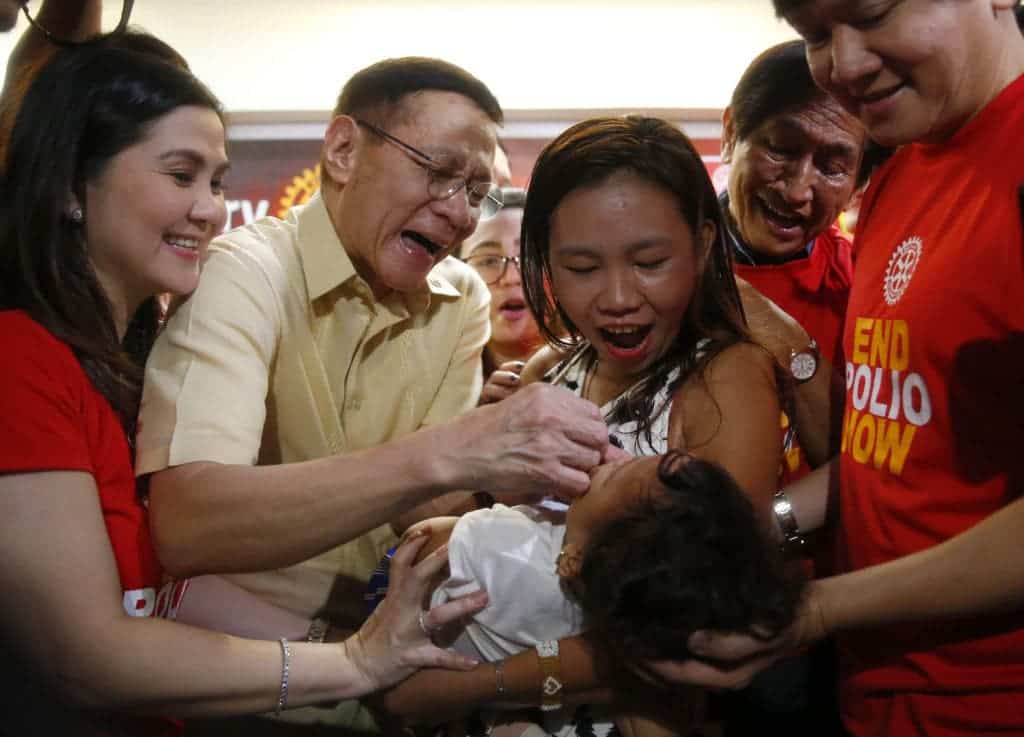
Humanity has eradicated another enemy (after smallpox in May 1980, and rinderpest or ‘cattle plague’ in October 2010). The independent Global Commission for the Certification of Poliomyelitis Eradication (GCC) has declared wild poliovirus type 3 to be globally eradicated. Announced on World Polio Day, this is a major milestone in the global effort to eradicate all poliovirus strains and ensure that no child will ever again be paralyzed by any poliovirus anywhere.

“This achievement is another giant step towards freeing the world from the crippling disease. The WHO European Region has massively contributed to this since it was declared polio free in 2002,” says Dr Nedret Emiroglu, Director of Health Emergencies and Communicable Diseases, WHO/Europe. “However, despite progress, there is still much left to be done across the globe. Continued work to reach every last child with the polio vaccine, strengthening routine immunization and surveillance, and ensuring safe containment of polio viruses, will be key to keeping polio at bay and protecting the gains achieved.”
Type 2 has been gone since 1999 leaving only Type 1, in Pakistan and Afghanistan. But vaccine resistance there has led to 88 cases so far this year, after only 33 all last year. So while the defeat of Type 3 is a welcome success, the WHO is still calling polio a Public Health Emergency of International Concern – and the emergency is now reaching a crunch point. “We face a very hard twelve months,” says Dr Michel Zaffran, director of polio eradication for the World Health Organization.
That isn’t only due to problems in Pakistan. The Type 2 vaccine virus replicates rapidly in humans, provoking strong immunity which is one of the reasons why wild Type 2 polio has long been wiped out while the other two types persisted.
The oral polio vaccine (OPV) contains an attenuated (weakened) vaccine-virus, activating an immune response in the body. When a child is immunized with OPV, the weakened vaccine-virus replicates in the intestine for a limited period, thereby developing immunity by building up antibodies. During this time, however, the vaccine-virus is also excreted and in areas of inadequate sanitation — this excreted vaccine-virus can spread in the immediate community (and this can offer protection to other children through ‘passive’ immunization), before eventually dying out. On rare occasions, if a population is seriously under-immunized, an excreted vaccine-virus can continue to circulate for an extended period, allowed to survive and mutate. In very rare instances, the vaccine-virus can genetically change into a form that can paralyse – this is what is known as a circulating vaccine-derived poliovirus (cVDPV).
Since 2017, circulating vaccine-derived poliovirus has caused more cases of paralysis than the actual wild poliovirus. To address this challenge, the entire world switched to a live vaccine with only polio Types 1 and 3 in 2016. Kids born since 2016, however, can transmit outbreaks of Type 2 vaccine virus, because they have not been given the live Type 2 vaccine.
There have been more outbreaks than predicted in 2016: ten in Africa this year, including countries such as Zambia, China and the Philippines. In the Philippines, a massive polio vaccine campaign was recently launched with community health workers and volunteers going door-to-door to give kids droplets of the oral vaccine. After being polio-free for almost two decades, polio is back in the Philippines.

The outbreaks can be stopped with live, type 2 vaccines, says Zaffran. The problem is that it seeds more reverted vaccine virus. A novel Type 2 vaccine virus, genetically modified to be even less likely to revert, might be the solution to the vaccine-derived poliovirus dilemma. Earlier this year, virologists in Antwerp reported that the vaccine was safe, well-tolerated, and successfully induced immunity in 30 people – who were isolated for a month in a custom-built “poliopolis” that kept the virus from escaping. Further trials are being done but the new vaccine virus is already being used by an Indonesian firm, Biofarma, to make live Type 2 vaccine.

Another challenge is donor fatigue. “We know that the last mile has proved to be the toughest phase of eradication,” says Zaffran. The Global Polio Eradication Initiative (GPEI) is now seeking $3.27 billion for its next four years of work, with a donor “pledging moment” scheduled for November 19 in Abu Dhabi.


